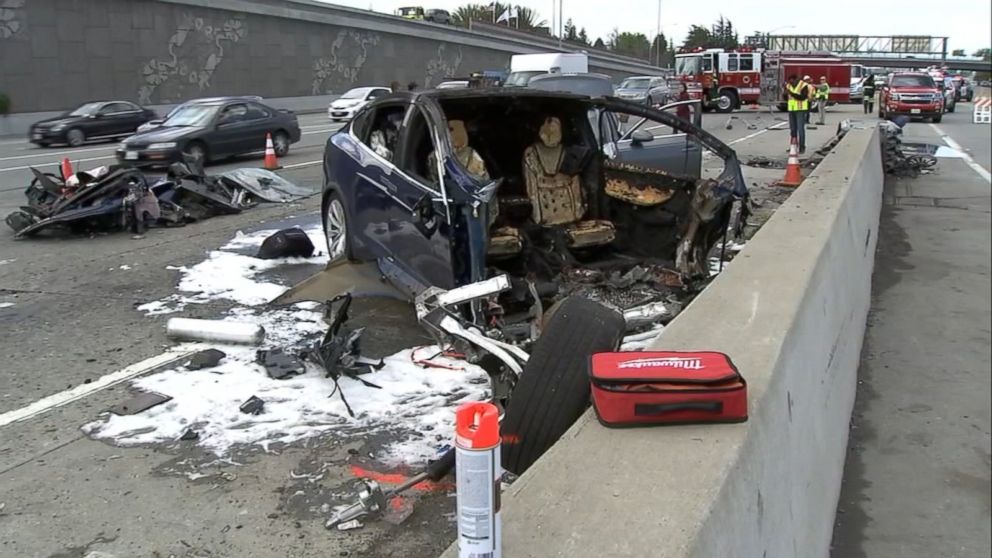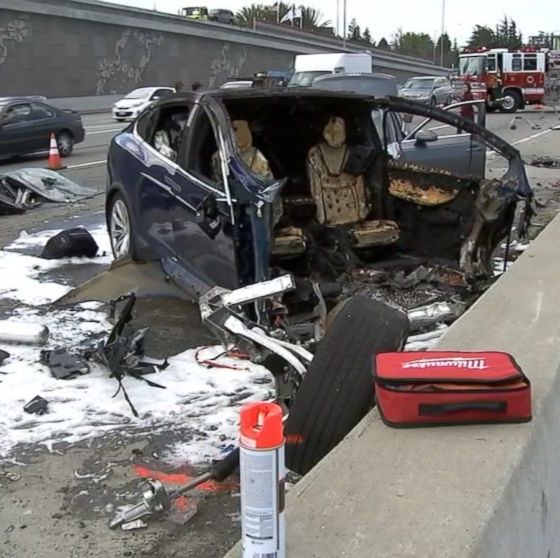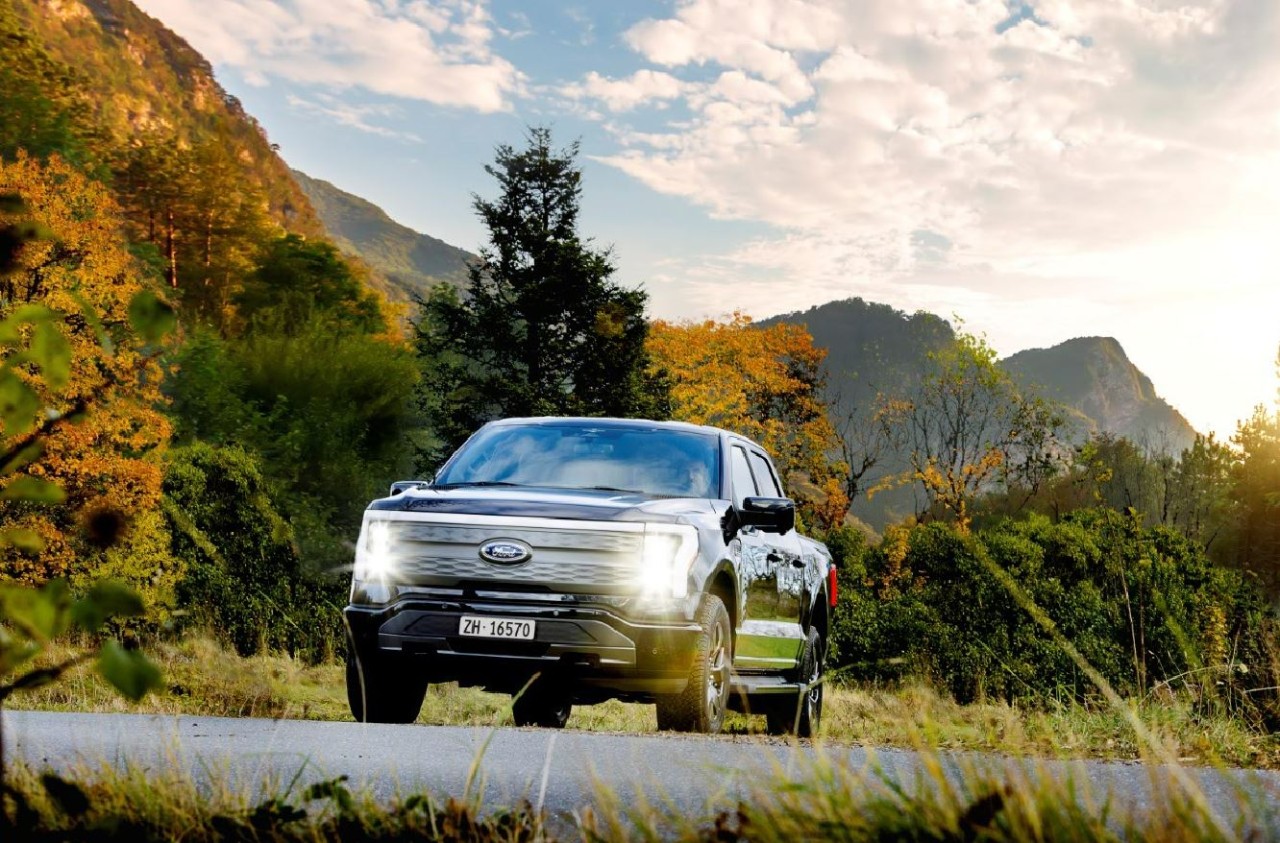

News
NTSB Prelim Report on fatal Tesla Model X crash: 8-seconds before impact
The National Transportation Safety Board has issued a preliminary report on the tragic Tesla Model X crash near Mountain View, CA in March. The NTSB’s preliminary report provided details about the circumstances leading up the accident, as well as observations about the all-electric SUV’s battery pack five days after the crash.
According to the NTSB, preliminary recorded data revealed that the Tesla Model X had its Autopilot engaged with Traffic-Aware Cruise Control set to 75 mph at the time of the accident. The vehicle collided into the crash attenuator, rotating it counterclockwise, removing the front part of the vehicle, and causing subsequent collisions with a 2010 Mazda 3 and a 2017 Audi A4. The NTSB noted that the vehicle’s performance data revealed the following.
- Autopilot was engaged on four separate occasions during the 32-minute trip. The driver-assist feature was engaged for the last 18 minutes 55 seconds before the collision.
- During the 18 minute, 55-second period, the Model X provided two visual and one auditory alert advising the driver to place his hands on the car’s steering wheel. The alerts were triggered more than 15 minutes prior to the accident.
- For the last 6 seconds before the collision, the Model X’s driver did not have his hands on the steering wheel.
- At 8 seconds before the crash, the Model X was following a lead vehicle at about 65 mph. At 7 seconds, the Model X began moving left while still following a lead vehicle. At 4 seconds, the Tesla was no longer following a car. At 3 seconds before the accident, the Model X’s speed increased from 62 mph to 70.8 mph. The vehicle’s emergency braking and evasive steering did not engage.
- During the collision sequence, the Model X’s lithium-ion battery was breached, causing a fire. The flames were extinguished after the Mountain View Fire Department applied about 200 gallons of water and foam during a period of fewer than 10 minutes. In the afternoon, the battery emanated smoke and audible venting was heard, though no flames were observed.
- On March 28, 5 days after the accident, the Model X’s battery pack reignited. The San Mateo Fire Department extinguished the fire.
The NTSB noted in its preliminary report that it is continuing work with the California Highway Patrol and the California Department of Transportation in investigating the accident. The NTSB stated that all aspects of the crash remain under investigation, and that it intends to issue safety recommendations to prevent similar incidents from taking place.
Tesla and the NTSB initially worked together in investigating the fatal Model X accident. The electric car company and the safety board eventually parted ways, however, due to Tesla’s decision to release crash data before the NTSB’s investigation was complete. Among the information Tesla released was that the driver did not have his hands on the wheel during the final 6 seconds leading up to the accident — information that has been reiterated in the NTSB’s preliminary report.
According to a Tesla, it opted to withdraw from its party agreement with the NTSB since collaboration with the safety board prevents the public release of safety information until the investigation was finished. People familiar with the matter, however, noted that the NTSB was the one which opted to terminate its collaboration with Tesla, according to a Bloomberg report.
In an update after the accident, Tesla highlighted that the absence of a crash attenuator — a highway safety device designed to absorb the impact of a collision — was already damaged when the Model X collided with the concrete barrier. In a statement to ABC7 News, Wil Huang, the brother of the ill-fated Model X driver, noted that a working crash attenuator would have saved his brother’s life. Later statements from CalTrans revealed that safety device had been left unrepaired for 11 days before the tragic Model X accident.

News
Ford cancels all-electric F-150 Lightning, announces $19.5 billion in charges
“Rather than spending billions more on large EVs that now have no path to profitability, we are allocating that money into higher returning areas, more trucks and van hybrids, extended range electric vehicles, affordable EVs, and entirely new opportunities like energy storage.”

Ford is canceling the all-electric F-150 Lightning and also announced it would take a $19.5 billion charge as it aims to quickly restructure its strategy regarding electrification efforts, a massive blow for the Detroit-based company that was once one of the most gung-ho on transitioning to EVs.
The announcement comes as the writing on the wall seemed to get bolder and more identifiable. Ford was bleeding money in EVs and, although it had a lot of success with the all-electric Lightning, it is aiming to push its efforts elsewhere.
It will also restructure its entire strategy on EVs, and the Lightning is not the only vehicle getting the boot. The T3 pickup, a long-awaited vehicle that was developed in part of a skunkworks program, is also no longer in the company’s plans.
Instead of continuing on with its large EVs, it will now shift its focus to hybrids and “extended-range EVs,” which will have an onboard gasoline engine to increase traveling distance, according to the Wall Street Journal.
“Ford no longer plans to produce select larger electric vehicles where the business case has eroded due to lower-than-expected demand, high costs, and regulatory changes,” the company said in a statement.
🚨 Ford has announced it is discontinuing production of the F-150 Lightning, as it plans to report a charge of $19.5 billion in special items.
The Lightning will still be produced, but instead with a gas generator that will give it over 700 miles of range.
“Ford no longer… pic.twitter.com/ZttZ66SDHL
— TESLARATI (@Teslarati) December 15, 2025
While unfortunate, especially because the Lightning was a fantastic electric truck, Ford is ultimately a business, and a business needs to make money.
Ford has lost $13 billion on its EV business since 2023, and company executives are more than aware that they gave it plenty of time to flourish.
Andrew Frick, President of Ford, said:
“Rather than spending billions more on large EVs that now have no path to profitability, we are allocating that money into higher returning areas, more trucks and van hybrids, extended range electric vehicles, affordable EVs, and entirely new opportunities like energy storage.”
CEO Jim Farley also commented on the decision:
“Instead of plowing billions into the future knowing these large EVs will never make money, we are pivoting.”
Farley also said that the company now knows enough about the U.S. market “where we have a lot more certainty in this second inning.”
News
SpaceX shades airline for seeking contract with Amazon’s Starlink rival

SpaceX employees, including its CEO Elon Musk, shaded American Airlines on social media this past weekend due to the company’s reported talks with Amazon’s Starlink rival, Leo.
Starlink has been adopted by several airlines, including United Airlines, Qatar Airways, Hawaiian Airlines, WestJet, Air France, airBaltic, and others. It has gained notoriety as an extremely solid, dependable, and reliable option for airline travel, as traditional options frequently cause users to lose connection to the internet.
Many airlines have made the switch, while others continue to mull the options available to them. American Airlines is one of them.
A report from Bloomberg indicates the airline is thinking of going with a Starlink rival owned by Amazon, called Leo. It was previously referred to as Project Kuiper.
American CEO Robert Isom said (via Bloomberg):
“While there’s Starlink, there are other low-Earth-orbit satellite opportunities that we can look at. We’re making sure that American is going to have what our customers need.”
Isom also said American has been in touch with Amazon about installing Leo on its aircraft, but he would not reveal the status of any discussions with the company.
The report caught the attention of Michael Nicolls, the Vice President of Starlink Engineering at SpaceX, who said:
“Only fly on airlines with good connectivity… and only one source of good connectivity at the moment…”
CEO Elon Musk replied to Nicolls by stating that American Airlines risks losing “a lot of customers if their connectivity solution fails.”
American Airlines will lose a lot of customers if their connectivity solution fails
— Elon Musk (@elonmusk) December 14, 2025
There are over 8,000 Starlink satellites in orbit currently, offering internet coverage in over 150 countries and territories globally. SpaceX expands its array of satellites nearly every week with launches from California and Florida, aiming to offer internet access to everyone across the globe.
Currently, the company is focusing on expanding into new markets, such as Africa and Asia.
News
Tesla Model Y Standard stuns in new range test, besting its Premium siblings
Tesla’s newer vehicles have continued to meet or exceed their EPA estimates. This is a drastic change, as every 2018-2023 model year Tesla that Edmunds assessed did not meet its range estimates.

The Tesla Model Y Standard stunned in a new range test performed by automotive media outlet Edmunds, besting all of its Premium siblings that are more expensive and more luxurious in terms of features.
Testing showed the Model Y Standard exceeded its EPA-estimated range rating of 321 miles, as Edmunds said it is the “longest-range Model Y that we’ve ever put on our loop.” In the past, some vehicles have come up short in comparison with EPA ranges; for example, the Model Y’s previous generation vehicle had an EPA-estimated range of 330 miles, but only drove 310.
Additionally, the Launch Series Model Y, the first configuration to be built in the “Juniper” program, landed perfectly on the EPA’s range estimates at 327 miles.
It was also more efficient than Premium offerings, as it utilized just 22.8 kWh to go 100 miles. The Launch Series used 26.8 kWh to travel the same distance.
It is tested using Edmunds’ traditional EV range testing procedure, which follows a strict route of 60 percent city and 40 percent highway driving. The average speed throughout the trip is 40 MPH, and the car is required to stay within 5 MPH of all posted speed limits.
Each car is also put in its most efficient drive setting, and the climate is kept on auto at 72 degrees.
“All of this most accurately represents the real-world driving that owners do day to day,” the publication says.
With this procedure, testing is as consistent as it can get. Of course, there are other factors, like temperature and traffic density. However, one thing is important to note: Tesla’s newer vehicles have continued to meet or exceed their EPA estimates. This is a drastic change, as every 2018-2023 model year Tesla that Edmunds assessed did not meet its range estimates.
Tesla Model Y Standard vs. Tesla Model Y Premium
Tesla’s two Model Y levels both offer a great option for whichever fits your budget. However, when you sit in both cars, you will notice distinct differences between them.
The Premium definitely has a more luxurious feel, while the Standard is stripped of many of the more premium features, like Vegan Leather Interior, acoustic-lined glass, and a better sound system.
You can read our full review of the Model Y Standard below:
Tesla Model Y Standard Full Review: Is it worth the lower price?









